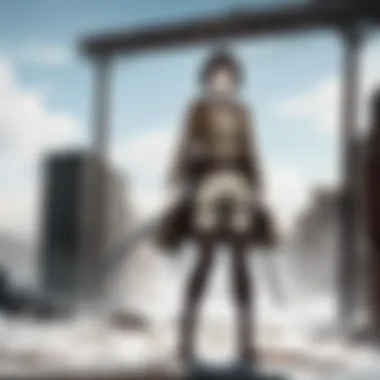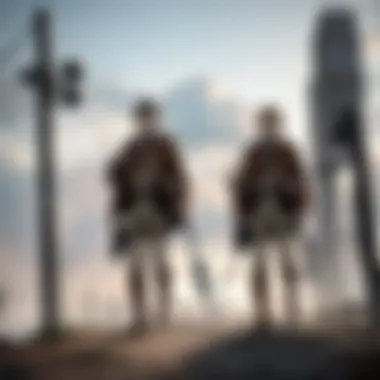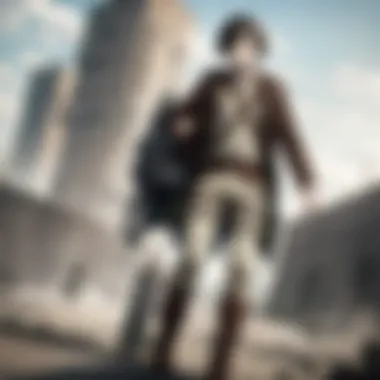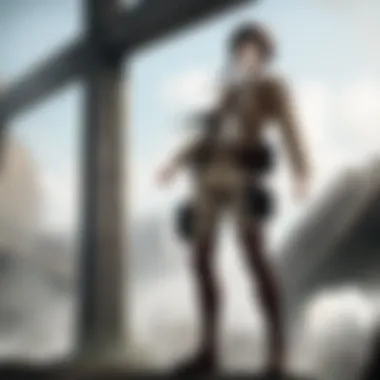Deep Dive into Attack on Titan Season Four: Part Two


Intro
As the anime community has witnessed the unfolding story of Attack on Titan, Season Four, Part Two marks a pivotal juncture in the series. With the conclusive events now in play, fans are poised to explore profound themes and character developments that shape the narrative. This season does not simply cater to the adrenaline-pumping action but engages deeper philosophical questions and moral dilemmas that challenge viewers' perceptions of right and wrong.
The significance of this season operates on multiple levels. Analyzing the character arcs provides insight into their motivations and evolutions. Each character grapples with their past while facing unprecedented choices that impact not just themselves but the entire world. Furthermore, understanding the thematic undercurrents reveals the cultural and ethical implications of this unfolding saga in a war-torn landscape.
This article seeks to delve into the complexities of Attack on Titan Season Four, Part Two. From character analysis to thematic exploration, it offers readers a comprehensive understanding of the anime's legacy and its resonance within broader societal conversations.
Overview of Attack on Titan
The significance of Attack on Titan extends far beyond its engaging story and action. This section will delve into the essence of the series, particularly as it sets the stage for the forthcoming exploration of Season Four, Part Two.
In understanding the overall narrative of Attack on Titan, one must recognize how the series has built a complex world filled with political intrigue and moral dilemmas. The events leading up to Season Four have laid solid groundwork for the conflicts and transformations that unfold. The series artfully interweaves themes of freedom, constraint and the relentless cycle of hatred.
A Brief Synopsis
Attack on Titan is set in a world where humanity is on the brink of extinction, confined within massive walls to protect themselves from gigantic humanoid creatures known as Titans. The story follows Eren Yeager, Mikasa Ackerman, and Armin Arlert among others, as they fight to reclaim their world from these monstrous beings. The narrative escalates as they confront revelations about the Titans' origin and the political dynamics of their own society.
In Season Four, Part Two, the intensity amplifies as Eren’s motivations become clearer and more morally ambiguous. The implications of his choices resonate throughout the remaining characters and the society around them. Understanding this premise helps unpack the critical themes discussed later in the article.
Significance in Anime Culture
The impact of Attack on Titan on anime culture is profound. The series has not only garnered a massive fanbase but it has also pushed the boundaries of what anime can explore thematically. It invites viewers to question their perspectives on freedom, sacrifice, and the cost of survival. Its contribution to the shonen genre is noteworthy, allowing deeper character exploration and narrative complexity.
Moreover, the anime has inspired considerable analysis and fan discussion across various platforms. Insights can be found in debates on Reddit and extensive articles on Wikipedia and Britannica detailing its narrative structure and thematic depth.
"Attack on Titan challenges viewers to grapple with their understanding of morality amid chaos, elevating it beyond mere entertainment to a philosophical inquiry."
In summary, this section establishes a foundational understanding of Attack on Titan. It highlights its rich narrative and cultural relevance, preparing readers for a more detailed review of the critical aspects that define Season Four, Part Two.
Structure of Season Four
The structure of Season Four serves as a critical framework in understanding the complex narratives within Attack on Titan. This section delineates the framework and pacing of the episodes, showcasing how these elements contribute to the overall storytelling of the series. A well-defined structure helps the viewer follow the intricate juggling of multiple character arcs and thematic elements that are central to the series. This clarity allows for a deeper engagement with the intricate storylines and character motivations.
Episode Breakdown
The episode breakdown is fundamental in analyzing the flow of Attack on Titan Season Four. This season consists of a total of 16 episodes, each meticulously crafted to build upon the emotional and narrative weight of the series.
- The first half of the season revisits the aftermath of Eren Yeager's drastic choices, showcasing how they reshape the world.
- Each episode typically blends strategic revelations with character-focused drama, driving the plot forward while maintaining character development.
- Key episodes such as "The War Hammer Titan" and "Above and Below" distinctly offer viewers pivotal revelations that shape both the plot and character dynamics.
Highlighting major events within these episodes reveals the intricate connections between character arcs and the overall narrative. For example, Eren's transformation is juxtaposed against the sacrifices of his old allies, intensifying the emotional stakes. This juxtaposition invites viewers to consider the complexity of loyalty and morality. By analyzing each episode, we can grasp how these transitions occur and their implications for the characters involved.
Pacing and Narrative Flow
The pacing of Season Four is noteworthy for its effective balance between action-packed sequences and quieter, more introspective moments. This varied tempo facilitates a more nuanced storytelling approach, allowing viewers to process significant character evolutions alongside high-stakes conflicts.


- The action sequences are strategically placed to punctuate dramatic revelations, offering a sense of urgency as well as a thematic pulse throughout the season.
- Conversely, slower moments provide necessary context and depth, enriching viewers’ understanding of character decisions.
A notable example of pacing can be seen in the contrasts between episodes focusing on Eren’s militaristic strategy and those centering on his emotional conflicts. This rhythmic alternation keeps the audience engaged and enriches the viewing experience.
In summary, the structure encompassing Attack on Titan Season Four is meticulous and intentional, promoting engagement with the franchise’s complex themes and characters.
Key Themes
The thematic depth of Attack on Titan Season Four, Part Two, serves as the backbone of the narrative, contributing significantly to its complex characters and the overarching storyline. Themes like freedom vs. constraint, morality and justification, and the cycle of hatred are not only pivotal for character development but also resonate with the socio-political contexts that reflect real-world issues. Each theme weaves into the fabric of the series, creating a rich tapestry that provokes thought and discussion among viewers.
Freedom vs. Constraint
In this arc, the struggle between freedom and constraint manifests through Eren Yeager's drastic choices. Initially, Eren is seen as a character yearning for freedom, keen to unleash the potential of the Titan powers to explore the world beyond walls. However, as his transformation evolves, stark contrasts emerge. Eren’s notion of freedom begins to infringe upon the lives and liberties of others, presenting the question: is true freedom attainable at the cost of oppression?
This tension reveals the moral quandaries faced by characters like Mikasa and Armin, who grapple with their loyalty to Eren versus their inherent desire to protect humanity. The show invites the audience to ponder the implications of absolute freedom and the ethical limitations that can be intertwined with such a quest.
Morality and Justification
The theme of morality and justification critically examines the actions taken by various factions throughout the series. Each character's choices are portrayed in shades of grey rather than black and white, raising questions about what constitutes a justifiable action in the pursuit of a perceived greater good. Eren’s methods become increasingly severe, leading fans to question whether the end justifies the means.
The divergence in moral philosophies is starkly illustrated through characters like Zeke Yeager, whose own vision for freedom diverges sharply from Eren's. The philosophical debates over morality are particularly compelling, as they resonate with the audience's understanding of real-world ethical dilemmas. The series does not provide easy answers; instead, it challenges viewers to engage with conflicting values and consider the consequences of both action and inaction.
Cycle of Hatred
Finally, the cycle of hatred is a recurring motif that depicts the devastating effects of vengeance and retribution across generations. Characters like Reiner Braun symbolize the perpetual loop of hatred that arises from trauma and conflict. His internal struggles highlight how individuals become products of their environments and histories. The show compellingly illustrates how revenge can lead to cycles of violence that ensnare both the victims and the perpetrators.
This theme urges viewers to reflect on the long-lasting impacts of war and the possibility of breaking this cycle through understanding and reconciliation rather than escalating conflicts. As alliances shift and betrayals unfold, the narrative deftly explores whether it is possible to dismantle the deep-rooted systems of animosity that shape the characters’ realities.
"The world is not as simple as choosing sides. It's understanding the pain on both ends.”
Character Development
Character development serves as the backbone of any storytelling, particularly in a series like Attack on Titan. Season Four, Part Two emphasizes this aspect significantly as it allows viewers to grasp the complexities of the characters’ motivations and growth. The transformation of major and minor characters provides layers to the narrative, making it more intricate and engaging. This deep dive into character arcs helps the audience to connect emotionally with the storyline, enhancing its overall impact.
Eren Yeager's Transformation
Eren Yeager stands at the center of the transformation narrative in this season. Initially portrayed as a determined and somewhat impulsive character, his evolution into a more ruthless figure is both shocking and thought-provoking. His actions force the audience to ponder the cost of freedom and whether the ends justify the means.
Throughout Season Four, Part Two, viewers witness Eren embracing the role of an antagonist. His motivations shift from a quest for liberty to a more complex ideology, where sacrifice becomes quintessential. This drastic change raises questions about his mental state and the influence of past traumas. Eren's character is no longer black and white; he embodies the ambiguity of heroism and villainy, inviting viewers to grapple with morally grey dilemmas.
The Role of Mikasa and Armin
Mikasa Ackerman and Armin Arlert continue to be integral to Eren’s story. Their contrasting approaches to conflict highlight the struggle between friendship and ideology. Mikasa’s unwavering loyalty to Eren creates tension as she grapples with his increasingly aggressive stance. She becomes a symbol of love and loyalty amidst chaos, showing the personal cost of Eren's decisions on those around him.
Armin, on the other hand, evolves into a voice of reason. His journey reflects the internal conflict of wanting to uphold human values while facing unthinkable challenges. Through his interactions with Eren, viewers see the impact of their shared history and divergent paths. Both characters serve to anchor the audience's understanding of Eren's transformation, creating a multifaceted narrative that isn’t just about him but also about the bonds of friendship that are tested.
New and Returning Characters


Season Four introduces significant new characters while also highlighting the development of beloved ones. Characters such as Gabi Braun and Falco Grice bring fresh perspectives to the ongoing conflict. Gabi, in particular, starts as a fierce warrior representing Marley’s viewpoint but soon undergoes her own transformation. Her journey mirrors Eren's in some ways, as she encounters the complexities of hate and revenge.
Returning characters also add depth to the narrative. The development of Reiner Braun as a symbol of the cycle of hate reflects the theme of redemption. His struggles and vulnerabilities contrast with Eren’s ruthless ambition, providing a narrative balance. Exploring these characters helps in understanding the psychological and emotional sides of war, making the series richer and more resonant.
"Character arcs in Attack on Titan are not merely a backdrop; they are instruments of storytelling that critique and analyze the human condition."
Narrative Techniques
Narrative techniques in Attack on Titan Season Four, Part Two play a crucial role in how the story unfolds and affects audience engagement. These approaches shape the themes and character development throughout the season. By utilizing various strategies, the show presents complex ideas about morality, freedom, and the nature of conflict, allowing for a deeper exploration of the story's intricacies. This section focuses on two main narrative techniques: flashbacks and time manipulation, alongside the varying perspectives that enrich the storytelling.
Flashbacks and Time Manipulation
Flashbacks in Attack on Titan serve as a storytelling device to reveal critical background information. They offer insights into characters’ pasts, motives, and emotional struggles. One notable example is Eren Yeager’s reflections on his earlier days in the walls. By revisiting these memories, audiences better understand his transformation and the burdens he carries.
In addition, time manipulation enhances the viewing experience. The use of non-linear timelines allows the narrative to present simultaneous events from different characters' perspectives. This technique emphasizes the theme of perspective in the series. By juxtaposing past and present, Attack on Titan crafts a sense of urgency and inevitability for its characters.
Employing these elements creates a multi-layered story. They provoke thought and engagement, crucial for the show’s appeal among fans. In this season, time manipulation makes the stakes higher and the characters' motivations clearer. The back-and-forth switching between timelines keeps viewers invested and hungry for resolutions.
Perspectives and Point of View
Point of view in Attack on Titan is vital in how the story is conveyed to the audience. The series frequently shifts between different characters, allowing for various interpretations of events. This narrative style enriches the complexity of the story and exposes viewers to differing truths.
The various perspectives create empathy for characters who may seem antagonistic at first. For example, seeing the narrative from the perspective of Marleys and Eldians adds depth to their struggles, highlighting the nuances in their motivations and fears. Instead of viewing them solely as villains or heroes, the audience gets a broader understanding of their situations.
Moreover, the shift in perspectives plays a significant role in building tension. As viewers gain insights from multiple characters, the impending conflicts become more relatable. The stakes feel higher, as audience members realize the intricacies involved in every decision made by each character.
Artistic and Technical Aspects
The artistic and technical elements of Attack on Titan Season Four: Part Two play a crucial role in shaping the viewer's experience. These aspects enhance the storytelling, evoke emotions, and create a more immersive atmosphere. Understanding how animation quality, character design evolution, and sound design collectively contribute to the season's impact is essential for a comprehensive analysis.
Animation Quality
The animation in this season is nothing short of groundbreaking. From the fluidity of the action sequences to the subtleties in character expressions, the production team, led by MAPPA, has elevated the series to new heights. The crisp visuals during battle scenes engage the audience, amplifying the stakes and intensity in moment. For example, the sequences showcasing the Titans' transformations or the maneuvering through the air vividly illustrate the urgency of the characters' struggle.
Moreover, the meticulous attention to detail adds depth. Backgrounds are rich and thoughtfully rendered, providing context without overshadowing the characters. This quality of animation not only captivates longtime fans but also appeals to newcomers. In essence, high-caliber animation functions as a conduit for the series' themes and character development.
Character Design Evolution
Character design in Season Four evolves significantly, reflecting the transformations within the story itself. Characters like Eren Yeager have undergone marked changes in both physical appearance and emotional complexity. Eren's design now portrays a darker, more intense version of himself, emphasizing the weight of his choices and the conflicts he faces. His grim demeanor, coupled with distinctive visual elements like his attire, symbolize the burdens he carries.
Returning characters also see subtle changes, indicating their growth or shifts in allegiance. Mikasa and Armin, for example, maintain their stylistic roots, but their designs adapt to showcase their internal struggles and alliances. This evolution in character design serves not only to illustrate change but also to enhance the narrative by visually representing the underlying themes of conflict and growth.
Sound Design and Music
Sound design and music in Attack on Titan Season Four: Part Two are integral to the storytelling process. The score, composed by Hiroyuki Sawano, brilliantly complements the action on screen, often rising to a crescendo that amplifies the emotional weight of pivotal moments. The use of orchestral arrangements mixed with electronic elements creates a soundscape that resonates with the viewers, allowing them to delve deeper into the narrative.


Additionally, the sound effects contribute to the overall atmosphere. The thundering footsteps of Titans, the whoosh of maneuver gear, and the ambient sounds of the environment work in tandem to create a sense of realism and urgency.
As a result, the meticulous attention to sound goes beyond mere background audio; it shapes viewers' emotional responses and immerses them into the world of Attack on Titan.
"The artistic and technical aspects work together seamlessly, making every element of Attack on Titan Season Four: Part Two essential to its narrative impact."
In summary, the artistic and technical components of Attack on Titan Season Four: Part Two are not mere enhancements but foundational elements that amplify the storytelling and emotional resonance throughout the series.
Cultural Impact
Cultural impact serves as a testament to the resonance of a series within the global zeitgeist. In the case of Attack on Titan, this impact is multifaceted, encompassing its influence on both anime fandoms and wider cultural discussions. As Season Four, Part Two unfolds, the show continues to prompt dialogues around complex themes like morality, power, and freedom. This relevance amplifies viewer engagement and fosters a community eager to dissect each element presented in the narrative.
Fan Theories and Discussions
The intricate plotting and character arcs of Attack on Titan invite diverse fan theories. Enthusiasts engage in discussions that extend beyond mere appreciation of the show. Theories often span various interpretations of Eren Yeager's motivations or the historical context provided within the narrative. Online platforms, such as Reddit, serve as forums for fans to share and debate their insights. Some theories suggest deeper meanings behind key events, such as the fate of Marley and the implications for Eldians.
These fan discussions not only reflect a keen understanding of the narrative but also enhance the viewing experience. Fans invest time in theorizing, prompting a deeper relationship with the material. Moreover, these theories tap into broader themes, questioning societal norms and replaying real-world historical echoes.
Global Reception and Controversies
The global reception of Attack on Titan has oscillated between immense acclaim and heated controversy. Critics often commend its ambitious storytelling and character development. For instance, the complex portrayal of Eren Yeager's transformation has sparked varied reactions. Some viewers appreciate his character journey, while others see it as a betrayal of his earlier ideals.
On the flip side, controversies surrounding certain plot elements can ignite passionate debates within the community. Themes involving nationalism and war are often critiqued for their sensitivity and the way they mirror real-life issues. This duality creates a fertile ground for discussions among fans and critics alike, making the show a cultural reference point in conversations about anime's role in addressing societal issues.
Ultimately, the cultural impact of Attack on Titan is defined by its ability to spur ongoing conversations. Fan theories and the dynamics of global reception contribute significantly to the show's legacy, ensuring that discussions surrounding its elements endure well beyond the final credits.
Epilogue
The conclusion of this analysis on Attack on Titan Season Four, Part Two serves as a significant reflection on the season's contributions to the series. Summarizing the key elements discussed throughout the article, it brings together themes of freedom, morality, and the cycle of hatred, allowing readers to appreciate the narrative depth. Understanding how these themes play out within character arcs and plot developments enriches the viewing experience.
Furthermore, this section highlights how the artistic and technical aspects elevate storytelling. High-quality animation and sound design create a visceral atmosphere, intensifying the emotional weight of scenes. By enjoying the finer details, audiences can better grasp the implications of character decisions and overarching narrative twists.
In addition to thematic explorations, a discussion of fan engagement and the global reception of the season reinforces its impact. The range of scholarly conversations and internet discussions signifies the cultural footprint of Attack on Titan. This interconnectedness invites viewers to reflect on their personal interpretations and expectations.
The importance of this conclusion lies in its ability to synthesize the conversation into actionable insights. As fans await future installments, acknowledging the nuances of Season Four, Part Two encourages ongoing dialogue and speculation. This reflection not only emphasizes the series' ongoing relevance but also prepares audiences for what lies ahead.
Final Thoughts on Season Four Part Two
In revisiting Attack on Titan Season Four, Part Two, one cannot overlook the profound transformation of characters such as Eren Yeager. His journey raises complex questions about leadership and sacrifice, resonating with contemporary societal dilemmas. The tension between duty and freedom depicted in the plot compels viewers to examine their own values in dire circumstances.
Moreover, the narrative's pacing and structure allow for a deep, layered experience. Each episode meticulously builds tension while providing backdrops that contextualize character motivations. This artistic decision plays a crucial role in establishing a connection with viewers, motivating them to ponder larger philosophical questions.
As we conclude this examination, it is clear that Attack on Titan Season Four, Part Two not only captivates through its storytelling but also challenges its audience to engage with difficult themes critically. The intricacies of character and narrative invite repeated viewings, ensuring that the show remains a significant topic of discussion across platforms.
Anticipation for Future Installments
Looking ahead, the anticipation for future installments of Attack on Titan is palpable within the anime community. With questions lingering about the fate of beloved characters and the resolution of long-standing conflicts, fans are eager for answers.
The buildup of tension throughout Season Four, Part Two creates high expectations for the conclusion of the series. Fans speculate on potential outcomes, discussing theories on forums such as Reddit and Facebook, which serve as breeding grounds for analysis and excitement. This engagement showcases the community's invested interest in the narrative's direction.
Additionally, the show's reputation for unexpected twists means that viewers should brace for surprises. As past seasons have challenged tropes within the anime genre, there is a rich potential for creativity and innovation in storytelling. This promise heightens the eagerness for the next chapters of Attack on Titan.
In sum, the conclusion emphasizes the importance of reflecting on past experiences while maintaining curiosity about future developments. Fans understand that the journey through this complex narrative is as vital as the destination, binding them closer to its world.



